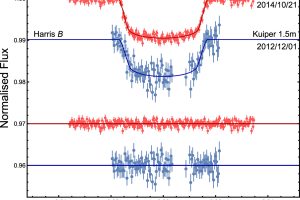The orbital inclination of 5 exoplanets is presented in teh study “The GAPS programme with HARPS-N at TNG XVI. Measurement of the Rossiter–McLaughlin effect of transiting planetary systems HAT-P-3, HAT-P-12, HAT-P-22, WASP-39, and WASP-60” of L. Mancini (University of Rome Tor Vergata), recently published by A&A

The discovery of hot Jupiters (Jupiter-like exoplanets in close orbits) has changed our view of planet formation. It is still debated whether hot Jupiters form in the present-day orbits or they form at large distances from their star and then they migrate inward. (e.g. Maldonado et al. 2018).
Planetary migration can be induced by several effects, mainly interaction between newborn planet and its protoplanetary disk, planet-planet scattering, or gravitational interaction in binary systems or during stellar close encounters. Each of these interactions affects the orbital inclination and eccentricity in a different way, providing observational clues to test their efficiency.
The sky projection (λ) of the inclination between the axis of the orbit and the rotation axis of the central star (ψ) can be calculated with accurate radial velocity measurements thanks to the Rossiter-McLaughlin effect. Radial velocity consists in Doppler shift which can be observed in the spectra of stars hosting exoplanets, due to the oscillation of the stellar position around the center of mass of the star-planets system. The Rossiter-McLaughlin effect is another Doppler effect that can be observed in rotating stars with transiting exoplanets. Because of stellar rotation, in fact, the emission from the portion of the star moving toward us is bue-shifted, while that from the portion moving in the opposite direction is red-shifted. During the transit of the exoplanet, if its orbit is not inclined both the red- and blue- shifted portions are occulted in the same way. If the orbit is inclined, hey are occulted in a different way, allowing us to derive the orbital inclination λ. If also the inclination of the stellar rotation axis is known, it is also possible to derive ψ.
Taking advantage of the Rossiter-McLaughlin effect and the high spectroscopic resolution of the spectra obtained for the project GAPS (Global Architecture of Planetary Systems) with the spectrograph HARPS-N mounted on the Telescopio Nazionale Galileo, the team led by the astronomer L. Mancini (Physic Department, University Tor Vergata of Rome) has measured λ of the hot Jupiters HAT-P-3, HAT-P-12, HAT-P-22, WASP-39 e WASP-60. Two of them (HAT-P-22, WASP-39) have orbits aligned with the stellar spin, while the orbital axis of HAT-P-3 b is slightly misaligned, HAT-P-12 b is strongly misaligned and WASP-60 b has a retrograde orbit. The study “The GAPS programme with HARPS-N at TNG. XVI: Measurement of the Rossiter–McLaughlin effect of transiting planetary systems HAT-P-3, HAT-P-12, HAT-P-22, WASP-39, and WASP-60” has been recently published by Astronomy & Astrophysics with the collaboration of the astronomers L. Affer, E. Gonzalez-Alvarez, A. Maggio, J. Maldonado, S. Masiero, G. Micela of the Astronomical Observatory of Palermo.
L’immagine (link) mostra la curva di luce del sistema WASP-60.
